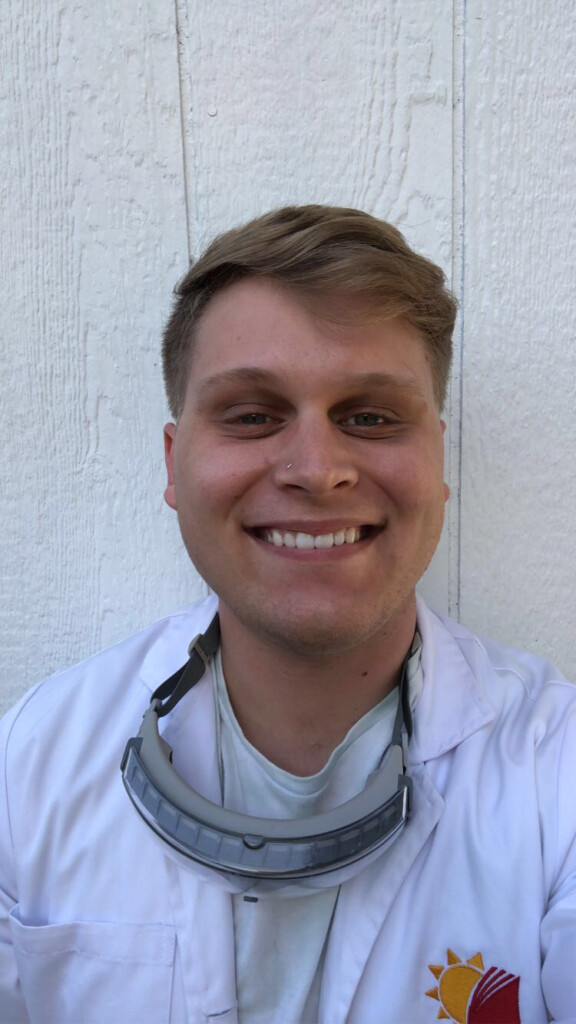2021 Chemistry Capstone Symposium
The 2021 Chemistry Capstone Symposium is virtual this year due to COVID-19. Students have prepared recorded versions of their presentations for viewing by internal audiences. Their talk titles and abstracts are listed below.
We are all disappointed not to be able to have our usual in-person celebration of our students and their work. At the same time, we have been very impressed by their extreme determination and persistence in this challenging and unprecedented time. They have been real troopers.
Way to go, class of 2021! We congratulate all of you on your hard work and accomplishments!
A-G
Functions and the Progress of Vaccination of Nipah Virus
Ann E. Buchholz, Senior Capstone Seminar
The Nipah virus belongs to the family henipaviridae, a class of deadly zoonotic agents, isolated mainly from fruit bats in Asia and Indonesia. A few notable outbreaks have been recorded since the 1990s, though it is believed that crossover events from bats into horses, pigs, or humans may occur annually. Nipah virus is classified as BSL4 pathogens as it has mortality rates between 40-100% and currently have no approved antivirals drugs or vaccines for humans. Currently, scientists must rely heavily on serology samples from both humans and bats to establish areas of outbreaks and prior infections. Scientific outreach and education, therefore, remains one of the main ways to combat such spillover events. Programs, such as the CDC’s “One Health” aims to teach individuals in affected areas about zoonotic viruses and help reduce the spread of disease.
Other laboratory techniques are used to analyze genes and proteins without working with live virus. These include Western blotting, Coomassie staining, PCR, and crosslinking assays. The ultimate goal is to better understand the Nipah virus in order to lead to the development of effective vaccines and other therapeutics. Promising results came out from a 2004 paper which had success with injecting Nipah virus glycoproteins and vaccinia virus recombinant proteins into hamsters, which displayed that all hamsters survived from this vaccination method after subsequent challenges. Another vaccination method written in 2019 used a multi-epitope vaccination that produced humoral and cell-mediated immunity. Developing vaccines based on mechanistic understanding of viral function, paired with education of zoonosis and spillover events provide a great combative ability to fight these deadly viruses.

Investigating Electronic and Ionic Conductive Polymers as Semiconducting Active Layer Channels for Development of Organic Electrochemical Transistors
Sinclair R. Combs, Senior Capstone Seminar
Conspectus: Organic electrochemical transistors (OECTs) are on the forefront of biosensing technology and integrated biological electronics. Thus, development of high-performance OECT devices are a strongly emerging field of research and development. Arguably, the most important component of these devices is the semiconducting active channel layer. This semiconductor is mostly commonly a conjugated polymer material. However, recent literature reports ways to significantly improve the performance of conjugated polymer materials as semiconductors in the aqueous OECT environment. In this account, we discuss the merits which qualify an OECT as high-performing and what materials have been shown to be most promising in this application. Additionally, we detail synthetic modification routes to optimally improve such semiconducting materials. We also discuss the effect of the interfacing electrolyte anion, characterization techniques, and report preliminary data from our own research endeavors on blending ion conductive and charge conductive polymers to use as an OECT active layer.

Stability, Toxicity, & Processing: Optimization Towards Commercial Perovskite Solar Cells
Dylan T. Cummins, Senior Capstone Seminar
In the past decade, perovskite solar cells (PSCs) have garnered significant attention due to their wide bandgap tunability, relatively inexpensive manufacturing costs, and high efficiencies that have rapidly increased to 25% – a value now competitive with commercially-dominant silicon cells. Currently, PSCs still face a number of developmental challenges that hinder their ability to be pushed into the commercial market. Instability is the most prominent drawback due to the cell structure’s high susceptibility to various routes of decomposition such as moisture permeation, photocatalyzed oxidation, and thermal degradation. Additionally, the contents of many popular metal halide perovskites contain lead and pose a considerable environmental risk in the case of industrial upscaling. This Account highlights recent strategies towards combating decomposition pathways for long-term stability, explores the feasibility of lead-free perovskites, and provides a discussion of manufacturing techniques that balance simple processing methods with high quality film production. Further optimization of PSCs reveal exceptional potential for competition, as well as integration, with silicon solar cells.

Iodobenzene Diacetate and its involvement in the Synthesis of a Structurally Novel Antibiotics Class
Emily Hicks, Senior Capstone Seminar
Antimicrobial resistance is a public health issue that the current classes of antibiotics are not equipped to handle. The majority of new drugs approved since the 1980s have been structural variants of previously established antibiotics, which is a short term but unsustainable solution for antimicrobial resistance. A long term solution is found in the use of diversity oriented synthesis (19), a synthetic approach with the goal of creating libraries of small drug-like molecules. Nitroso compounds generated with “ene”-reactions are a candidate for a structurally novel antibiotics class as they have been shown to have activity against Micrococcus luteus, a Gram-positive bacterium. We investigated but were unable to confirm or deny the viability of iodobenzene diacetate as an oxidizing agent for in-situ “ene”-reactions to synthesize nitroso compounds.

Green Synthesis of Hydroxyureas from DMDTC
Dana L. Hiett, Senior Capstone Seminar
Hydroxyureas have been used in medicine since the mid 1900’s, and the biological impacts of these molecules have been widely studied in relation to tumor suppression, alleviation of sickle cell disease symptoms, and many others. As the medicinal properties of these compounds have been discovered and tested, the synthesis of these compounds has been drawing attention in order to optimize the production and specialization of the medications. In the past, hydroxyurea synthesis has been achieved by various methods, including the utilization of carbamates, carbamoyl azides, and phosgene pathways, however each of these routes fall short with regard to environmentalism in their procedural approaches. The synthesis of hydroxyureas through mechanisms containing DMDTC (dimethyl dithiocarbamate) as a reactant allow for greener synthesis of these compounds while retaining their ability to be customized with different R groups. This synthesis mechanism shows favorable atom economy while simultaneously consisting of more environmentally friendly aqueous reagents and easy purification of intermediates and products through vacuum distillation.

The Efficacy of Platinum Catalysts in Anticancer Therapy
Salma A. Ibrahim, Senior Capstone Seminar
Platinum complexes are essential for chemotherapeutic purposes. Cisplatin, a highly effective chemotherapy drug, exhibits toxic drawbacks that affect normal tissue environments. Studies have been conducted to find alternatives to the platinum (II) complex. However, the emergent anticancer drugs, oxaliplatin and carboplatin, are still deemed toxic based on their low median lethal dose or LD50. Modification to the six-coordinate PtIV complex has shown significant progress in minimizing the cytotoxicity and the resistance observed in cisplatin. Varying the ligand at the axial position for a platinum (IV) complex can also help regulate the reduction rate of a prodrug to an active platinum (II) complex. Other strategies such as functionalization with nanoparticles, have contributed to the safer delivery of the therapy drugs with an increase in drug accumulation to cancer regions. Photoactivation of these upconverted nanoparticles with Near Infrared Radiation (NIR) can promote bioimaging and improve the understanding of the mechanism of action of a given chemotherapy drug.

Detecting dopamine on ruthenia-modified pyrolytic carbon electrodes
Hannah S. Jeffries, Senior Capstone Seminar
Ruthenium dioxide increases the electron transfer kinetics of carbon electrodes, which generally exhibit slow electron transfer. Electrodes can be used to detect neurotransmitters such as dopamine (DA) which has a multitude of effects on the human body. Carbon electrodes were synthesized due to their practicality and coated in ruthenium dioxide to be used for DA detection. Different DA concentrations (10 mM – 1 nM) in 1 M perchloric acid solution were tested on a carbon electrode and then again on the same electrode coated in ruthenia. The calculated limit of detections for carbon and ruthenia were 643 nM and 45 nM respectively. These values are within one standard deviations of each other, so it is not yet possible to determine if ruthenia increases the limit of detection or limit of quantitation of carbon, though ruthenia has better analytical sensitivity than carbon.

Development of Antibiotic Resistance and Tumorigenesis through Adaptive Mutagenesis
Seth E. Koivisto, Senior Capstone Seminar
While we typically think of mutations arising from errors during DNA replication prior to cell division, there is a growing body of evidence that suggests an alternative hypothesis for their generation. Adaptive mutagenesis (AM) involves non-dividing cells mutating in response to a selective pressure that prevents them from growing, with the mutation allowing them to spontaneously begin dividing. There is no consensus mechanism for this process, however, there is evidence that points towards transcriptional mutagenesis (TM) being involved to some degree. In this Account, we will demonstrate a proposed mechanism for AM and lay out the evidence that supports it. We will also discuss the consequences of AM in both single-celled and multicellular organisms, and point out directions for future research in this field.
One possible mechanism of adaptive mutagenesis is that of retromutagenesis. Here, a non-dividing cell undergoes TM in order to produce a mutant protein that allows it to grow in sub-optimal conditions, such as nutrient starvation or antibiotic presence. Now that the cell is dividing, it then undergoes replicational mutagenesis (RM) at the same mutation site, which ensures it passes on the mutation that allows it to divide to its progeny. This Account will describe the evidence that supports this hypothesis for the adaptive mutagenesis mechanism, as well as pointing out key areas where it differs from the traditional ideas of RM.
As they do not have to support any other cells, single-celled organisms always benefit from being able to divide. If the factor preventing them from dividing is the presence of an antibiotic, then these microbes can use AM to evolve a resistance to the drugs typically used to kill them, which is extremely problematic given the devastating rise of superbugs across the planet. Typically, however, antibiotic resistance arises from the horizontal gene transfer of antimicrobial resistance genes, and this Account will compare how the two processes might be used by a bacterial cell. By contrast, AM in a multicellular organism may lead to cancer, as cells under growth arrest in a multicellular organism are in that state to support the health of the individual. In this Account, we look at these consequences in more detail, as well as the current state of research into how AM (more specifically, AM by retromutagenesis) leads to these consequences in both prokaryotic and eukaryotic systems. We conclude with a discussion of where further research is required, and how the process of AM affects our world today.

The effects of a solid polymer electrolyte’s structure on its conductivity and viability for use in batteries
Michael Larson, Senior Capstone Seminar
Portable electronic devices have completely changed the way our world works, allowing instantaneous communication to just about every person on earth. The chemical reactions that take place within the rechargeable lithium-ion batteries are the key source of energy that fuels our consumption of information and entertainment. Lithium-ion rechargeable battery are the industry standard, powering everything from our phones to electric vehicles. In 2019 global annual production of LIB was 300 GWh and it is estimated that by 2025 global production will reach 1200 GWh.1 Electric vehicle manufacturer Tesla reports that when their new Gigafactory in Berlin is up and running it alone will produce 250 GWh.2 This is all to say lithium-ion batteries have taken over the world for consumer electronics and vehicles. With all of these batteries in the world now, the question is how safe and sustainable the manufacturing and use of these are. Lithium-ion batteries contain a non-aqueous liquid electrolyte such as lithium hexafluorophosphate (LiPF6) dissolved in DMC, EMC, or ethylene carbonate.3 The stability of the electrolyte allows for over 2000 recharge cycles with 80% charge capacity retention, though there is the drawback of the safety of the electrolyte itself. When punctured, overcharged, short-circuited, or any other damage to the battery, the volatile organic carbonates can ignite and lead to runaway reactions. Common stories of this include the Samsung Galaxy Note 7 which frequently short circuited and exploded in people’s pockets, as well as the danger of electric vehicles crashing and piercing the battery.4,5 It is therefore imperative that a new electrolyte is designed to replace these dangerous and volatile organic liquid electrolytes, one of which could be a solid polymer electrolyte (SPE).

“Analyzing Single-cell RNA sequencing Data from Tumor-reactive CD8+ T cells using Monocle Analysis Platform”
Thu Le, Senior Capstone Seminar
In the past two decades, immunotherapy has revolutionized treatment for cancer and remarkably shifted the field of oncology. Immunotherapy has become a first-line treatment for certain cancers especially for patients who have been resistant to chemotherapy and radiation therapy. Unlike other types of oncological therapies which directly trigger both healthy and cancer cells, immunotherapy has renovated the field of oncology by primarily targeting immune cells. Hence, it effectively boosts the immune system to recognize and attack cancer cells. Despite the great revolution, the survival rate remains no greater than 20 percent. Due to malignant nature of tumor microenvironment, cancer comprehensively recruit many complex cellular intrinsic and extrinsic components to expand the tumor and to develop a variety of resistance pathways.
CD8+ T cell proliferation, activation and differentiation play a central role in defeating the threat of cancer cells and protecting the immune system. However, persistent antigen stimulation such as that associated with chronic viral stimulation or advanced cancer can induce an exhausted state in which the effector functions of CD8+ T cells that offer protection against invaders and cancerous cells are diminished. To overcome CD8+ T cells exhaustion, immune checkpoint inhibitor (ICIs) blockade is introduced to induce T cell responses. In the case of ICIs, immune cells are activated to transform into effector cells to destroy cancer cells. As the immune system is enabled to attack its invaders, it induces a strong and durable immune memory.
Many open questions about the effect of immunotherapy on the immune systems and cancer cells remain. To answer these, it is essential to construct such computational methods that can help analyze and characterize both immune and cancer cells, to observe whether patients will likely respond to the treatment. Recognizing the central role of computational techniques to study cancer, we illustrate how single-cell RNA sequencing (RNA seq) can provide insight into CD8+ responses associated with cancer immunotherapy. To do this, we used, Monocle, a promising computational platform that allows us to observe different types of cell at a single-cell level; technique that has only been used over the last several decades. Herein, we observed single, tumor reactive CD8+ T cells isolated from 6 cancer patients who were undergoing ICIs therapy. We studied gene expression, finding biologically interesting gene, expression patterns that are associated with CD8+ T cell exhaustion and effector function to probe the immune response to treatment with a goal to improve clinical trials and patient care.

Expanded Approaches and Techniques using Natural Products in Antibiotic Resistance
Raven Lirio, Senior Capstone Seminar
The antibiotic resistance crisis is a priority in medical research due to the rapid growth of multidrug-resistant (MDR) bacteria. Previous research has primarily focused on the extraction of natural products in nature as a means of combating evolving bacteria, but a number of different techniques and strategies are being explored. Methods like semisynthesis and natural product antibiotic combinations are more frequently utilized to build upon research and more effectively fight infections. Further explorations on new advances in technology and multidisciplinary approaches as also expanded current approaches to tackling evolving bacteria. In this account, a brief overview of these new techniques and approaches are addressed to showcase the breadth of ongoing research into antibiotic resistance.

Superconformal Au Electrodeposition Using a Rotating Disk Electrode
Kristen M. Long, Senior Capstone Seminar
Microelectrodes can be used to detect various biomolecules, such as metabolites, neurotransmitters, and amino acids, that can help with the early diagnosis and treatment of certain neurological conditions, such as Parkinson’s disease. These microelectrodes can be synthesized via electrodeposition utilizing various metal nanoparticles. In particular, gold nanoparticles have been more widely studied in this field due to their distinct chemical and physical attributes as well as their chemical stability. In order to synthesize gold microelectrodes, superconformal Au deposition can be conducted in various scaffolds on the scale of 5-10 μm using a Na3Au(SO3)2 and Na2SO3 electrolyte solution containing varying concentrations of Bi3+ (2-10 μM) to catalyze the reduction reaction of Au(SO3)23-. A rotating disk electrode (RDE) was used in order to ensure a continuous flow of fresh ions towards the working electrode through a vortex mechanism. This account summarizes methods for achieving bottom-up gold filling using sulfite-based electrolytes and the various attempts at shortening the incubation time that precedes deposition without compromising bottom-up deposition. It was found that shortening the incubation time from 180 to 110 minutes was possible if deposition began at a more negative applied potential before transitioning to a less negative applied potential. Additionally, it was shown that higher Bi3+ concentration increased both deposition rate and amount. More negative potentials were also shown to decrease deposition time by shortening the incubation time prior to deposition. These results also demonstrated that the deposition of Au had a strong dependence on hydrodynamics with higher rotation rates leading to bottom-up void free filling. Lastly, the pH of the electrolyte could alter whether deposition was flat or concave and determined how positive the applied potential would need to be in order to achieve bottom-up filling in various trench depths on the scale of 5 to 45 μm.

Transcriptional mutagenesis as a mode for adaptive mutagenesis, and its involvement in cancers
Aria E. Manning, Senior Capstone Seminar
The mechanism and implications of transcriptional mutagenesis are of interest to many scientists. DNA integrity is of great important because DNA provides the code for the creation of proteins. DNA lesions can occur spontaneously or due to environmental pressures such as UV radiation. Cells have specialized repair systems to repair these lesions before replication or transcription can occur, however occasionally these repair systems fail to fix a lesion. Transcriptional mutagenesis (TM) describes the bypass of a DNA lesion by RNA polymerase, leading to erroneous protein production. This process is also a proposed mechanism for adaptive mutagenesis, which is a phenomenon observed in prokaryotes and eukaryotes where mutated cells arise in the absence of cell division in response to a selective pressure. Retromutagenesis, the process of these lesions leading to an adaptive benefit and an inheritable mutation, could help explain adaptive mutagenesis. TM is of major interest when studying multicellular organisms because of the possibility that TM can cause cancer if the DNA lesion affects the cell cycle. Proto-oncogenes and tumor suppressor genes are vital in ensuring the cell cycle is maintained and uncontrolled cell proliferation does not occur. TM occurring involving erroneous proteins produced by oncogenes or damaged tumor suppressor genes could alter the cell cycle leading to tumor growth and cancer development.

The Synthesis of Single Ion Conducting Solid Polymer Electrolytes Based on Oxanorbornene Dicarboximide Backbone with Different Sidechains Via Ring-Opening Metathesis Polymerization and Click Chemistry
Phuc N. Phan, Senior Capstone Seminar
The current organic electrolytes in lithium batteries can pose safety concerns due to their volatile and flammable properties. The dendrite formation can form between the electrodes causing the battery to fail. This study focuses on the production of different oxanorbornene dicarboximide backbone polymers’ covalently bonded by trifluoromethane sulfonimide (TFSI) via click reaction. The polymer allows the lithium ions to freely flow and conduct. The poly(ONDI-12) has been tested with Tg measurements. Compared to varying side chain lengths of 3,5, and 8, the n =12 is more optimal. Currently, the study is trying to attach TFSI group to the polymer by different click chemistry conditions. During the study, ring opening metathesis polymerization (ROMP) is utilized to synthesize a variety of homopolymer, copolymers, and block copolymers.

Molecular Mechanisms of SSRI Therapeutics
Benjamin W. Soderling, Senior Capstone Seminar
Selective serotonin reuptake inhibitors (SSRIs) are the most common prescribed class of anti-depressants, well regarded for their relatively mild side effects and their high efficacy rates in treating depression and anxiety. SSRIs act on the Serotonin (5-HT) transporter proteins located in the axons of signaling neurons to inhibit the reuptake of serotonin into the sending cell. By doing so they increase the concentration of available serotonin in the synaptic cleft for uptake by the receiving neuron. The effect of the increased level of serotonin is thought to be a down regulation of the sympathetic nervous system, resulting in a calmer state of mind for those who experience anxiety. Though these drugs have been around for decades, and continue to be one of the best therapeutic options for depression and anxiety, their exact mechanism of action is still unknown. In this article, we will discuss the structures of the most commonly prescribed SSRIs, mention some interesting new methods of synthesis for them, and propose a model for how SSRIs bind to the active site of the 5-HT transporter protein based on the common functional groups found across these compounds. Future research of the 3D protein structure of 5-HTT could result in smarter, more potent drugs that could be given in smaller doses to reduce the side effects common to current drugs on the market.

Oligomeric side chain length effects on Ion conductivity in solid polymer electrolytes
Judson M. Yancey, Senior Capstone Seminar
Solid polymer electrolytes are being developed towards the end of enhancing battery performance and safety. Rigid backbone polymers that can decouple segmental motion have been the interest of Dr. Waldow and his research group in recent years. Continuing from previous work done with polymers based on oxanorbornene dicarboximide monomers with varying lengths of oligomeric ethylene oxide side chains (up to n=12), a longer chain length of n=17 was synthesized. The goal of this experiment is to determine if increasing the side chain length of OEO to n=17 on oxanorbornene dicarboximide can increase the rate of segmental relaxation without imparting crystallization.




Social Media